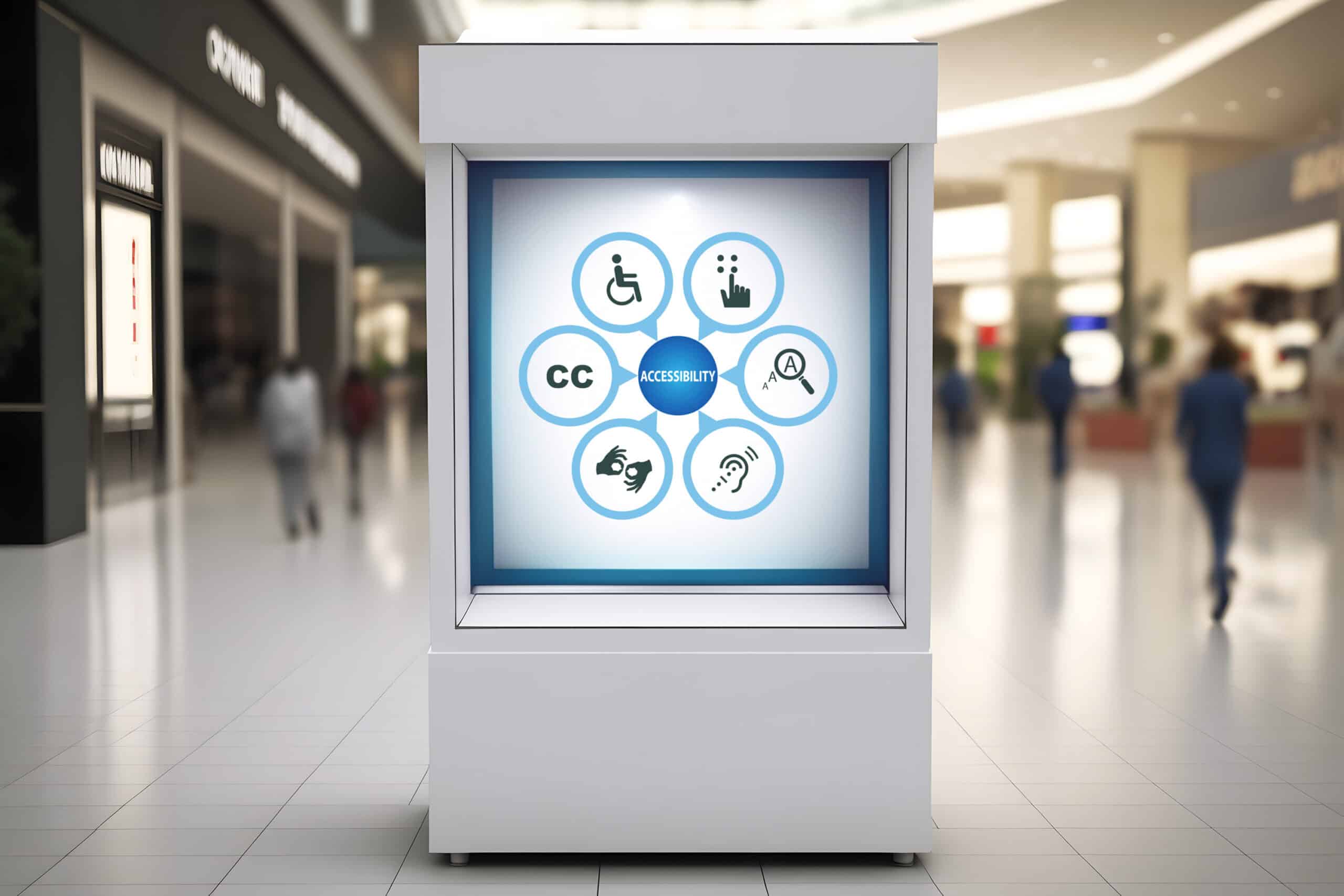All kinds of businesses use digital retail signage to give customers an engaging and informative experience, whether it’s through attention-grabbing interactive kiosks, vibrant menu displays, or wall-to-wall, interconnected video screens.
However, digital signs are only effective if your customer base can sufficiently see, hear, or touch them as needed, regardless of ability or disability.
Improving accessibility in your retail signage design is not only good for business and customer engagement, it’s also a legal imperative under the Americans with Disabilities Act (ADA).
Here’s how you can move toward a more universal digital signage design that is accessible and useful for a diverse audience.
Digital Signage Presents Unique Accessibility Challenges and Opportunities
Since its inception, the ADA has developed specific technical requirements for non-digital signs in businesses and public buildings, including for signs disclosing exits, restrooms, emergency services, and other important information.
By law, these types of signs must use a variety of accessibility features, from tactile elements and standardized symbols to high-contrast text and non-glare finishes.
Due to its many technical features and advanced capabilities, digital retail signage introduces more complex challenges to accessibility, as well as more opportunities for reaching audiences with disabilities. Digital signs are highly customizable, for example, which gives you the chance to develop interactive experiences that can be adjusted for each customer’s abilities.
But before you can start designing more accessible digital signs in your business, it’s important to consider the types of disabilities you may encounter in your customer base.
Understanding Your Audience
According to the Centers for Disease Control and Prevention (CDC), approximately one in four American adults has some type of disability.
Depending on their severity, physical and cognitive disabilities can make it difficult for those affected to interact with technology, move around without assistance, and carry out activities such as reading text and listening to audio information.
Keep these CDC statistics about disabled American adults in mind as you plan more accessible digital signage:
- 12.1% have difficulty walking or climbing stairs
- 12.8% have difficulty with cognitive functions such as concentrating and making decisions
- 6.1% are deaf or have serious hearing impairments
- 4.8% are blind or have serious visual impairments
Making Digital Retail Signage Accessible to All
Digital signs are endlessly customizable and offer a number of features that can help make information available to all users. Here are a few things to consider to make your signs more accessible to customers with disabilities.
Screen height
One of the most important aspects of designing accessible digital signage is screen height. The ADA requires that wall-mounted screens must not protrude more than four inches from a wall. Additionally, digital screens need to be installed at least 27 inches from the ground and no higher than 80 inches from the ground. These specifications ensure that signage is visible and, if necessary, touchable by customers in wheelchairs, children, and shorter adults.
Length of reach
Length of reach is another key accessibility factor with digital signage, especially when it comes to interactive screens. ADA compliance rules require that touchscreen signs inside enclosures be no higher than 48 inches off the ground and within 20 inches of a customer’s reach.
Incorporating a slight slope in small user kiosk areas can also help most customers to reach touchscreens, regardless of their size or disability.
Features for customers with visual and hearing disabilities
Having vision and hearing impairments can make it difficult for customers to perceive and understand information presented on digital signs.
Luckily, there are a few adjustments you can make that can go a long way toward accessibility.
Including more audio elements and voice-responsive technology in signs and interactive kiosks can aid customers who have difficulty reading text and discerning video and other visual media. You may also add additional signage in braille for customers who are legally blind and rely on tactile elements to read.
Using easy-to-understand and vibrant visual elements can help hearing-impaired customers receive information they may otherwise miss from audio-based sign elements. Another helpful tool for hearing-impaired customers who may have difficulty with spoken communication is interactive wayfinding signage that shows them visually how to get around your establishment.
Training your staff
No matter how advanced and accessible your business’s digital signs are, disabled customers may still require assistance from a member of your staff.
Along with making signs more accessible, it would be wise to invest in training for your team to help them understand the disabilities some customers experience so that they can be better prepared to help.
Simply starting a conversation about how to help customers with disabilities with staff can be beneficial, too. When everyone is more knowledgeable, they will be more confident in assisting disabled customers and can contribute ideas on how to make every facet of your business more accessible.
Accessible Retail Signage with Spectrio
Maximizing the accessibility of your business’s digital signs can create a more welcoming and inclusive environment, improve customer engagement, and ensure that you comply with the laws put in place by the ADA.
Our team at Spectrio can help you put together an accessible digital signage system that is useful for a universal audience while also accomplishing your business’s day-to-day goals.
To learn more about our services and our accessibility features and options, contact us to book a demo today.
